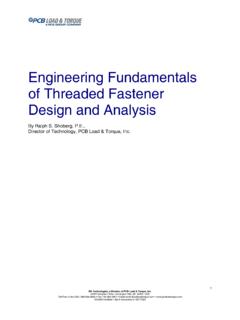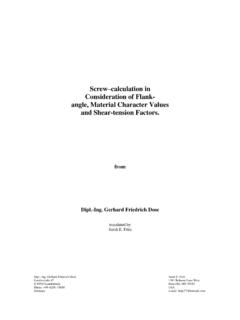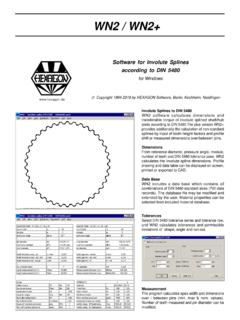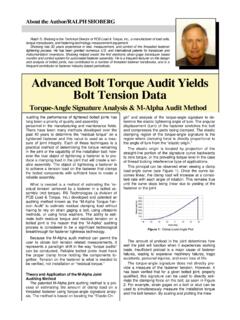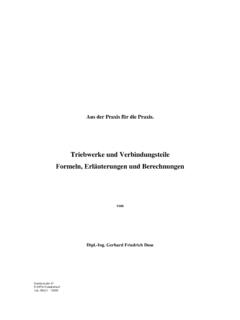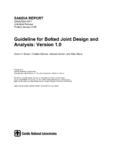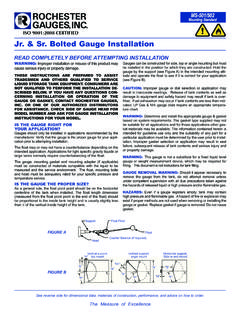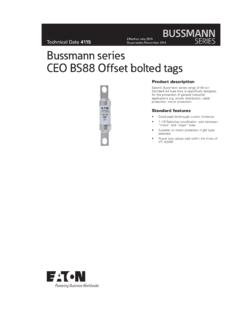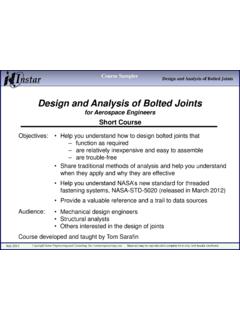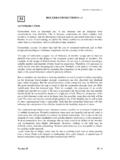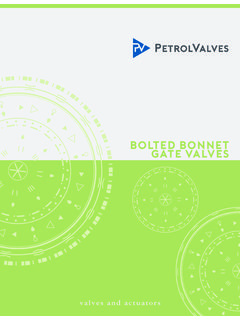Transcription of A Procedure for Calculation of Torque …
1 Journal of ASTM International, March 2005, Vol. 2, No. 3. Paper ID JAI12879. Available online at John D. Reiff, A Procedure for Calculation of Torque Specifications for Bolted Joints with Prevailing Torque ABSTRACT: This paper presents procedures developed for the Calculation of the coefficient of friction of bolt/nut assemblies and for the Calculation of Torque specifications, which include the case where the fasteners have prevailing Torque KEYWORDS: fastener Torque , prevailing Torque , Torque Calculation , head finish, thread finish Nomenclature The following is a list of the nomenclature used.
2 Most terms are consistent with the nomenclature used in the VDI 2230 Procedure . A0 Smallest cross-section area of bolt AS Effective tensile stress cross-section of the bolt thread per ISO 898-1. D0 Outside diameter of bolt at the smallest cross-section, A0 (smaller of DS or DT). D2 Pitch diameter of bolt thread D3 Minor diameter of bolt thread Dkm Effective diameter for friction at the contact of the head of the driven fastener DS Diameter at stress cross-section AS. DT Shank diameter of bolt neck DW Outside diameter of the contact area under the head of the driven fastener FM Assembly preload, bolt tensile load at tightening FM, Assembly preload, bolt tensile load at which the equivalent stress is Rp, FM,MIN Minimum assembly preload expected from tightening to the specified Torque FM,MAX Maximum assembly preload expected from tightening to the specified Torque MA Assembly input Torque MA,MIN Maximum assembly input Torque MA,MAX Minimum assembly input Torque MA,PRE Assembly prevailing Torque MG Assembly thread Torque .
3 Moment in the bolt neck P Pitch of the bolt thread Rp, % proof stress of bolt material per ISO 898-1. di Inside diameter of hollow bolt dh Inside diameter of the contact area under the head of the driven fastener th Half flank angle of the bolt thread ( /6 for ISO thread). G Coefficient of friction between bolt and nut thread G,MIN Minimum coefficient of friction between bolt and nut thread Manuscript received 15 May 2004; accepted for publication 29 November 2004; published March 2005. 1. General Motors Corporation, 30001 Van Dyke Ave., Warren, MI. Copyright 2005 by ASTM International, 100 Barr Harbor Drive, PO Box C700, West Conshohocken, PA 19428-2959.
4 2 JOURNAL OF ASTM INTERNATIONAL. G,MAX Maximum coefficient of friction between bolt and nut thread K Coefficient of friction at the contact of the driven fastener head K,MIN Minimum coefficient of friction at the contact of the driven fastener head K,MAX Maximum coefficient of friction at the contact of the driven fastener head ges Coefficient of friction; both head and thread friction are equal e Equivalent stress m Tensile stress Torsional stress Degree of exploitation of bolt yield stress desired at maximum assembly condition Introduction Tightening tests and methods for Calculation of the coefficient of friction at the driven fastener's bearing surface and at the thread contact area are specified in the ISO standard for Fasteners Torque /Clamp Force Testing (16047) and in the German national standard, Determination of Coefficient of Friction of Bolt/Nut Assemblies Under Specified Conditions (DIN 946).
5 A method for the Calculation of Torque specifications which requires these friction coefficients is described in the well-known Procedure , Systematic Calculation of High Duty Bolted Joints (VDI 2230). These procedures and Calculation methods are developed and applicable only for the case where the fasteners have no significant prevailing Torque . Prevailing Torque is the Torque required to turn the driven fastener before any clamping force (or bolt tension) is generated. In the automobile industry many critical attachments are designed with fasteners that include prevailing Torque features, such as all-metal prevailing Torque nuts.
6 The error resulting from the application of the standards (referred to above) for Calculation of fastener friction and Torque specifications has been determined to be of significant magnitude. Therefore, new Calculation procedures have been developed and are described in this paper. For the case with no prevailing Torque , these same equations can be used but with the value of prevailing Torque set to zero. Theory Equations for Calculation of Friction The following equations are developed for calculating the coefficient of head friction ( K). and the coefficient of thread friction ( G) from data measured during a nut/bolt tightening process.
7 During the tightening process, measured values include input Torque (MA), thread Torque (MG), and bolt tension (FM). A mathematical model of the tightening process has been developed by Motosh [1] and is modified here to include the prevailing Torque term (MA,PRE): (M A M A, PRE ). FM = (1). P D D . + G 2 + K km . 2 2 cos th 2 . Where: REIFF ON Calculation OF Torque SPECIFICATIONS 3. Dw + d h Dkm = (2). 2. This equation is rearranged to solve for input Torque , which is reacted by the Torque under the head of the driven fastener (head Torque ) and the Torque at the contact of the nut and bolt threads (thread Torque ): P D D.
8 M A = M A, PRE + FM + G 2 + FM K km (3). 2 2 cos th 2 . input thread Torque head Torque Torque Thread Torque includes: P G D2 . M G = M A, PRE + FM + (4). 2 2 cos th . And the head Torque is the difference of input Torque minus thread Torque : D . M A M G = FM K km (5). 2 . Equation 4 is rearranged to solve for thread friction: 2 cos th M G M A, PRE P . G = (6). D2 FM 2 . Equation 5 is rearranged to solve for head friction: 2(M A M G ). K = (7). Dkm FM. And finally, if head friction and thread friction are assumed to be equal, then ges is substituted for G and K in Eq 3, and the equation is rearranged to solve for friction: M A M A, PRE P.
9 FM 2 . ges = (8). D2 Dkm . + . 2 cos th 2 . Equations 6 and 7 are used to calculate the coefficients of head and thread friction from the measurement of prevailing Torque , input Torque , and thread Torque , at a selected value of bolt tension during assembly of fasteners in a laboratory test. 4 JOURNAL OF ASTM INTERNATIONAL. Equations for Calculation of Torque specification The following equations are developed for calculating a Torque specification , utilizing the coefficients of head and thread friction calculated using equations above. During the assembly of the fasteners, the bolt shank and threaded section are stressed in tension and additionally in shear due to the applied Torque .
10 The equations are developed to allow for the Calculation of an upper Torque specification limit that will result in a desired maximum equivalent stress in the bolt shank due to the tension and shear combined stresses. The minimum Torque specification is calculated to result in a specified tolerance so that the tightening process will be statistically capable for a selected tightening tool. For example a Torque specification tolerance of 15 %. might be required to have a capable process with a selected mechanical clutch shutoff tool. The equivalent stress in the bolt due to the tensile stress and the torsional stress from the maximum distortion energy theory of failure) is: e = M2 + 3 2 (9).
